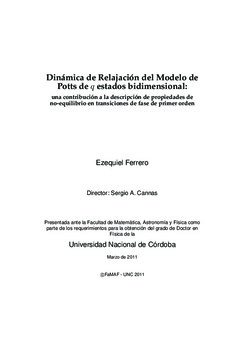| dc.contributor.advisor | Cannas, Sergio Alejandro | es |
| dc.contributor.author | Ferrero, Eduardo Ezequiel | es |
| dc.date.accessioned | 2011-09-06T15:27:33Z | |
| dc.date.available | 2011-09-06T15:27:33Z | |
| dc.date.issued | 2011-03 | es |
| dc.identifier.uri | http://hdl.handle.net/11086/163 | |
| dc.description | Tesis (Doctor en Física)--Universidad Nacional de Córdoba. Facultad de Matemática, Astronomía y Física, 2011. | es |
| dc.description.abstract | Estudiamos el modelo de Potts de q estados bidimensional, que presenta transiciones de fase magnéticas con temperatura de primer (q > 4) y segundo orden (q = 4). Trabajamos con simulaciones tipo Monte Carlo para las cuales implementamos distintas técnicas algorítmicas, incluyendo una implementación en GPUs. No obstante, presentamos también algunos resultados analíticos. Analizamos la Dinámica de Tiempos Cortos en la aproximación de Campo Medio del modelo de Potts con q=2 resolviendo exactamente la ecuación de Fokker-Planck asociada a la dinámica de Glauber. Confirmamos la validez de la hipótesis de escala de la Dinámica de Tiempos Cortos tanto cerca del punto crítico como de puntos spinodales. Mostramos que es posible definir el punto spinodal a partir del comportamiento dinámico del sistema a tiempos cortos. Estudiamos la metaestabilidad asociada a la transición de fase de primer orden para el modelo de Potts de q estados con q > 4. Realizamos un estudio sistemático de la dinámica del modelo de Potts luego de un enfriamiento brusco a temperaturas subcríticas. Para q > 4 advertimos la existencia de diferentes regímenes dinámicos, de acuerdo al rango de temperaturas. Caracterizamos estos regímenes y los correspondientes estados del sistema. | es |
| dc.description.abstract | We analyze the bidimensional q-state Potts model, a paradigmatic model in
the study of Statistical Mechanics of Critical Phenomena and Phase Transitions,
which presents first (q > 4) and second order (q ≤ 4) temperature driven magnetic phase transitions and has shown a very rich dynamic phenomenology. We
mostly work on Monte Carlo numerical simulations, for which we have implemented different algorithm techniques, both traditional and original, including
an implementation to run code on graphics cards. Nevertheless, we also present
analytic results for some cases where this approach was possible.
We study the Short Time Dynamics in the Mean-Field approximation for the
2-states Potts model (the Curie-Weiss model) solving the Fockker-Planck equation associated to the Glauber dynamics for this model. We obtain closed-form
expressions for the first moments of the order parameter, near to both the critical and spinodal points, starting from different initial conditions. We confirm the
validity of the short-time dynamical scaling hypothesis in both cases.
We show that it is possible to define the spinodal point through the short
time dynamical behaviour of the system; our definition works both for meanfield and short-range interactions systems. We study the the first order phase
transition associated metastability for the q-state Potts model with q >4. We show
that the spinodal point is clearly separated from the transition point for all q >
4, delimiting an interval of temperatures capable to hold metastable states. We
provide numerical evidence for the existence of metastable states associated to
the first order phase transition. We analyze the relaxation mechanism from these
states to equilibrium.
We perform a systematic study about the nonequilibrium dynamics of the
Potts model on the square lattice after a quench from infinite to subcritical temperatures. We analyze the long term behaviour of the energy and relaxation time
for a wide range of quench temperatures and system sizes. For q > 4 we found
the existence of different dynamical regimes, according to quench temperature
range. We characterize those regimes and the system’s corresponding states. We
analyze in detail the finite size scaling properties of different relaxation times
involved, as well as their temperature dependency. | en |
| dc.format.extent | 215 páginas | es |
| dc.language.iso | spa | es |
| dc.rights | Atribución-NoComercial-SinDerivadas 2.5 Argentina | * |
| dc.rights.uri | http://creativecommons.org/licenses/by-nc-nd/2.5/ar/ | * |
| dc.subject | Stochastics analysis methods | en |
| dc.subject | Monte Carlo methods | en |
| dc.subject | Lattice theory and statistics | en |
| dc.subject | Phase transitions | en |
| dc.subject | Classical spin models | en |
| dc.subject | Static properties | en |
| dc.subject | Domain walls and domain structures | en |
| dc.subject.other | Dinámica de relajación | es |
| dc.subject.other | Modelo de Potts | es |
| dc.subject.other | Simulaciones numéricas | es |
| dc.subject.other | Simulaciones en GPUs | es |
| dc.subject.other | Estados Metaestables | es |
| dc.subject.other | Puntos Spinodales | es |
| dc.subject.other | Dinámica de tiempos cortos | es |
| dc.subject.other | Ecuación de Fokker-Planck | es |
| dc.subject.other | Transiciones de fase | es |
| dc.subject.other | Mecánica estadística de no-equilibrio | es |
| dc.title | Dinámica de relajación del modelo de Potts de q estados bidimensional: una contribución a la descripción de propiedades de no-equilibrio en transiciones de fase de primer orden | es |
| dc.type | doctoralThesis | es |





